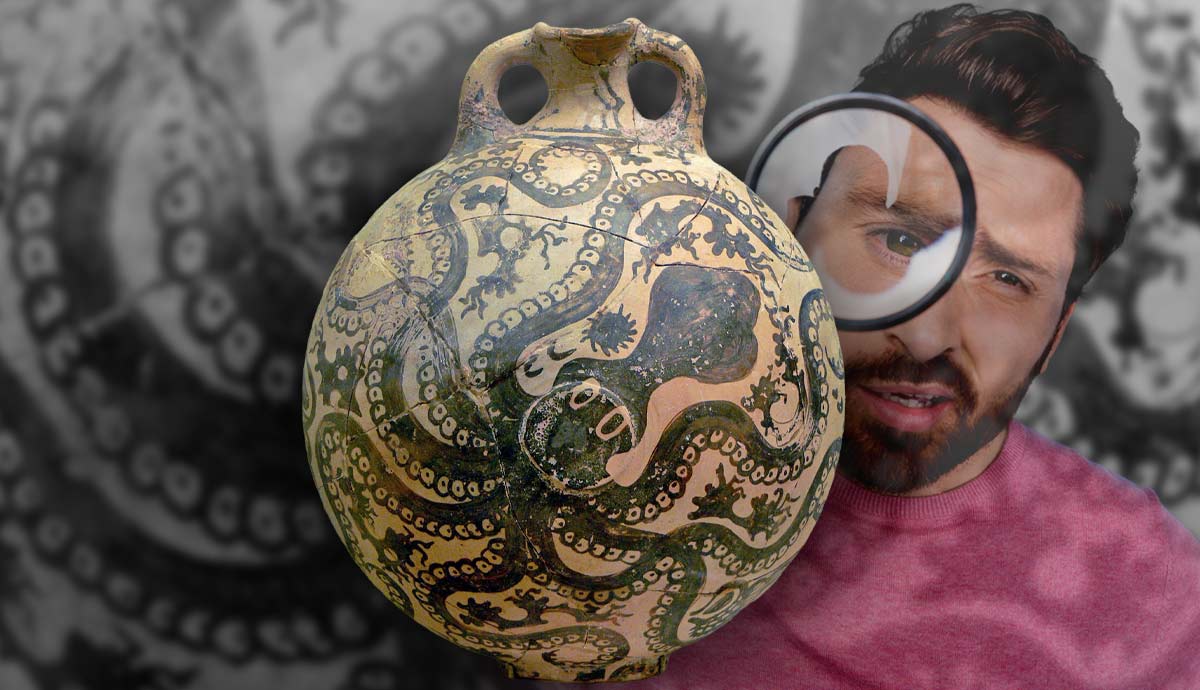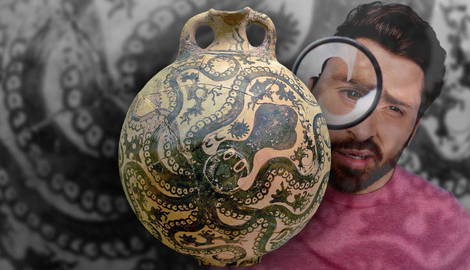
Craftsmen from the Minoan civilization, a society that existed during the Bronze Age on the Greek island of Crete, created the famous Minoan Octopus vase. Their vases typically featured artistic portrayals of a sinuous octopus and were created at a time when the Minoans were doing a lot of trading by sea. The vase design rose to prominence between 2000 BC and 1450 BCE. The vases have been found by archaeologists in many places where the Minoan and Mycenaean civilizations resided.
Pottery in Minoan Civilization: A Brief History

Known for their unique architecture and colorful art, the Minoan people are thought to be the first civilization in Europe. Today, remnants of their palaces at Phaistos and Knossos draw many visitors. The society rose from around 3100 BC and by about 2000 BC, the Minoans had built fairly sophisticated cities for their time. From approximately 1450 BC, the civilization is said to have been dominated by the Mycenaean Greeks who lived in mainland Greece.
That said, Minoan art mainly consisted of beautifully decorated pots, statues, carved stones and colorful wall paintings. Common themes included nature and religion. Often described as uplifting and surreal, Minoan art was unique for its time.
Minoan Pottery Techniques

The Minoan people used a wide range of pottery techniques. Moreover, their pottery styles were noticeably different and varied in design according to location and time periods. Minoan pottery created to hold ointments and oils has been found on the islands in the Aegean Sea, in Cyprus, and Syria.
The items include vases, small statues, and urns. Some designs such as the rhyton cup were made from soft stone like steatite. Among the most popular pottery designs made during the Middle Minoan era was Kamares ware. The pottery designs were sold across the Aegean region and are among the finest examples of Minoan pottery. The biggest collection of these pots can be found in the Heraklion Archaeological Museum in Crete.
Style Depicted on an Octopus Vase From Crete

The Marine Style of making pottery in Crete is credited with giving rise to the development of the Minoan Octopus vase. The vases appeared around 1500 BC and often featured illustrations of octopuses. Looking at the dimensions, the famous Minoan Octopus vase found at Palaikastro, was about 27 centimeters (10.5 inches) tall. This was the typical average height for a Minoan Octopus vase at the time.
Found in Palaikastro, a town on Crete island, the vase is a great example of exquisite Minoan pottery. The vase was likely made on a spinning pottery wheel and then painted by hand. It has a unique shape with two flat, round parts, each most likely made separately with high-quality clay.

The vase illustrates the pottery-making skills of the Minoan people during the Late Minoan period. A section of researchers believe that the piece was made by the Marine Style Master, an artist who worked in Palaikastro. The pottery style became popular when Minoan traders started to sail across the Mediterranean Sea and reached far-away lands such as Cyprus, Egypt, and the Levant. Some historians believe that their sailing experiences helped to inspire sea-themed pottery. Potters from mainland Greece and islands such as Aegina and Melos are said to have tried to imitate the style, but they were unable to match their skill.
How the Minoan Octopus Vase Was Made

There is not much information about how the Minoan Octopus vase pottery was made. However, there is speculation that the designs were made in small workshops run by skilled craftsmen, often living in villages that were situated close to high-quality clay sources. For some, making pottery might have been a part-time job or a hobby alongside farming. However, there is evidence to suggest that the progressively better quality of pottery was made by experts who worked full-time. Workshops may also have been of two kinds with one catering to the elites. Researchers have been trying to piece together evidence to deduce how the items were made by comparing items from Crete and those from Mesopotamia and Egypt.

Going by current evidence, the potter’s wheel appears to have been used from a certain time period, though other handmade techniques were still used to allow for carved designs. Notably, glazing was not used and none of the pottery appears to have been baked at very high temperatures. Additionally, the highest quality pieces often had very thin walls. The discovery of an old pottery oven at Kommos in Crete with malformed pots has helped to provide researchers with vital information about the Minoan Octopus pottery processes.







